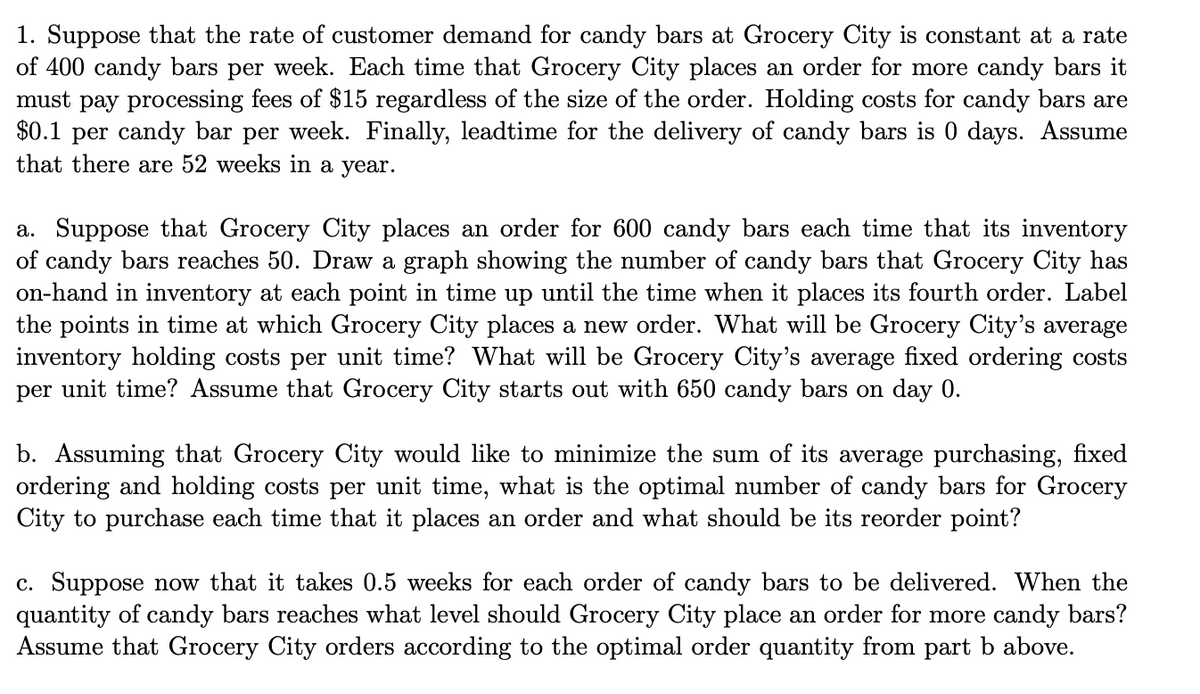1. Suppose that the rate of customer demand for candy bars at Grocery City is constant at a rate of 400 candy bars per week. Each time that Grocery City places an order for more candy bars it must pay processing fees of $15 regardless of the size of the order. Holding costs for candy bars are $0.1 per candy bar per week. Finally, leadtime for the delivery of candy bars is 0 days. Assume that there are 52 weeks in a year. a. Suppose that Grocery City places an order for 600 candy bars each time that its inventory of candy bars reaches 50. Draw a graph showing the number of candy bars that Grocery City has on-hand in inventory at each point in time up until the time when it places its fourth order. Label the points in time at which Grocery City places a new order. What will be Grocery City's average inventory holding costs per unit time? What will be Grocery City's average fixed ordering costs per unit time? Assume that Grocery City starts out with 650 candy bars on day 0. b. Assuming that Grocery City would like to minimize the sum of its average purchasing, fixed ordering and holding costs per unit time, what is the optimal number of candy bars for Grocery City to purchase each time that it places an order and what should be its reorder point? c. Suppose now that it takes 0.5 weeks for each order of candy bars to be delivered. When the quantity of candy bars reaches what level should Grocery City place an order for more candy bars? Assume that Grocery City orders according to the optimal order quantity from part b above.
1. Suppose that the rate of customer demand for candy bars at Grocery City is constant at a rate of 400 candy bars per week. Each time that Grocery City places an order for more candy bars it must pay processing fees of $15 regardless of the size of the order. Holding costs for candy bars are $0.1 per candy bar per week. Finally, leadtime for the delivery of candy bars is 0 days. Assume that there are 52 weeks in a year. a. Suppose that Grocery City places an order for 600 candy bars each time that its inventory of candy bars reaches 50. Draw a graph showing the number of candy bars that Grocery City has on-hand in inventory at each point in time up until the time when it places its fourth order. Label the points in time at which Grocery City places a new order. What will be Grocery City's average inventory holding costs per unit time? What will be Grocery City's average fixed ordering costs per unit time? Assume that Grocery City starts out with 650 candy bars on day 0. b. Assuming that Grocery City would like to minimize the sum of its average purchasing, fixed ordering and holding costs per unit time, what is the optimal number of candy bars for Grocery City to purchase each time that it places an order and what should be its reorder point? c. Suppose now that it takes 0.5 weeks for each order of candy bars to be delivered. When the quantity of candy bars reaches what level should Grocery City place an order for more candy bars? Assume that Grocery City orders according to the optimal order quantity from part b above.
Practical Management Science
6th Edition
ISBN:9781337406659
Author:WINSTON, Wayne L.
Publisher:WINSTON, Wayne L.
Chapter2: Introduction To Spreadsheet Modeling
Section: Chapter Questions
Problem 33P: Assume the demand for a companys drug Wozac during the current year is 50,000, and assume demand...
Related questions
Question

Transcribed Image Text:1. Suppose that the rate of customer demand for candy bars at Grocery City is constant at a rate
of 400 candy bars per week. Each time that Grocery City places an order for more candy bars it
must pay processing fees of $15 regardless of the size of the order. Holding costs for candy bars are
$0.1 per candy bar per week. Finally, leadtime for the delivery of candy bars is 0 days. Assume
that there are 52 weeks in a year.
a. Suppose that Grocery City places an order for 600 candy bars each time that its inventory
of candy bars reaches 50. Draw a graph showing the number of candy bars that Grocery City has
on-hand in inventory at each point in time up until the time when it places its fourth order. Label
the points in time at which Grocery City places a new order. What will be Grocery City's average
inventory holding costs per unit time? What will be Grocery City's average fixed ordering costs
per unit time? Assume that Grocery City starts out with 650 candy bars on day 0.
b. Assuming that Grocery City would like to minimize the sum of its average purchasing, fixed
ordering and holding costs per unit time, what is the optimal number of candy bars for Grocery
City to purchase each time that it places an order and what should be its reorder point?
c. Suppose now that it takes 0.5 weeks for each order of candy bars to be delivered. When the
quantity of candy bars reaches what level should Grocery City place an order for more candy bars?
Assume that Grocery City orders according to the optimal order quantity from part b above.
Expert Solution
This question has been solved!
Explore an expertly crafted, step-by-step solution for a thorough understanding of key concepts.
This is a popular solution!
Trending now
This is a popular solution!
Step by step
Solved in 2 steps with 2 images

Recommended textbooks for you

Practical Management Science
Operations Management
ISBN:
9781337406659
Author:
WINSTON, Wayne L.
Publisher:
Cengage,

Practical Management Science
Operations Management
ISBN:
9781337406659
Author:
WINSTON, Wayne L.
Publisher:
Cengage,